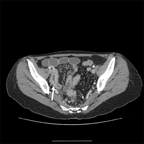Imaging Developments in Crohn's Disease
How Do I Choose Between Computed Tomography and Magnetic Resonance Imaging for My Crohn's Disease Patients? Is There Still a Role for Barium?
Cross-sectional imaging has revolutionized disease activity assessments in Crohn’s disease patients. This is driven by two key management concepts for inflammatory bowel disease (IBD). The first is that symptoms often do not correlate with Crohn’s disease activity. Multiple alternate etiologies for a patient’s symptoms can be present including gastrointestinal infections, irritable bowel syndrome, bacterial overgrowth, and/or bile acid-induced diarrhea. Given the potential risks of potent immunosuppressive regimes, it has become imperative to obtain objective IBD activity assessments before escalation of therapy or altering management plans. The second concept is that cross-sectional imaging with computed tomography enterography (CTE) or magnetic resonance enterography (MRE) complements endoscopy. Radiologic imaging provides an evaluation of disease beyond the mucosal surface (intramural disease, penetrating complications, and extra-intestinal disease manifestations) and interrogates intestinal regions outside the reach of standard endoscopic approaches. CTE and MRE, in concert with endoscopy, generate more accurate and comprehensive global disease evaluations in Crohn’s disease.
Imaging Applications
CTE and MRE have become the gold standards for radiologic small bowel assessments in Crohn’s disease. Both techniques utilize a large volume of neutral or negative oral contrast to enhance transmural inspection. Features of active disease include mural hyperenhancement, mural stratification, bowel wall thickening, increased mesenteric fat density, and engorged vasa recta (also known as the comb sign) (Figure 1). In those with suspected Crohn’s disease, CTE or MRE is often used to help confirm the diagnosis and assess the extent of disease. In those with an established diagnosis, these procedures can assess disease activity, response to treatment, exclude penetrating complications (Figure 2), and evaluate for stricturing disease. Several studies have demonstrated that CTE or MRE alters management plans in up to 50% of Crohn’s disease patients. These imaging techniques have greatly expanded the diagnostic armamentarium available to clinicians.

Images: Bruining DH

How Does One Choose Between Computed Tomography Enterography and Magnetic Resonance Enterography?
Intrinsic test features and patient characteristics can help health care providers decide which imaging modality to select. Studies have now demonstrated a similar diagnostic performance between CTE and MRE for detecting small bowel inflammation. Compared to MRE, CTE is more widely available, and lower in cost and has a higher interobserver agreement, higher image quality, and a shorter image acquisition time. However, MRE avoids ionizing radiation exposure, can be safely performed during pregnancy (but avoid gadolinium in the first trimester), and is preferred when perianal disease is suspected. Both CTE and MRE must be utilized with caution in patients with renal disease, due to the risk of renal failure (intravenous computed tomography contrast) and nephrogenic systemic fibrosis (risk factors include gadolinium exposure and renal failure). MRE is contraindicated in those with metallic foreign bodies including implanted cardiac devices.
When choosing between CTE and MRE, one should focus on selecting the best imaging test for an individual patient. I often order CTE as the initial imaging examination in newly diagnosed Crohn’s disease patients, severely ill patients who are less likely to tolerate a longer MRE procedure, or those individuals who would have difficulty avoiding movement during magnetic resonance assessments (severe pain, rigors, or tremor). I prefer MRE in pediatric patients, in young patients (less than 35 years old), especially if they had previous CT exposures, and in those with perianal disease (I request MR imaging of the pelvis at the time of MRE.). While the data behind ionizing radiation exposure risk from medical procedures (computed tomography) are not certain at low doses, in the interest of public safety, one should assume that some risk may exist. In most patients, when serial imaging or follow-up occurs, it should be performed with MRE when available.
Several imaging scoring systems have recently been developed. This includes the Magnetic Resonance Index of Activity (MaRIA) score, which includes the parameters of disease extent, wall thickness, relative contrast enhancement, edema, and ulceration. The MaRIA score is an objective measure of disease activity in patients with luminal disease, and radiologic severity has been shown to correlate with endoscopic appearance. Other scoring systems have been developed to assess activity in patients with perianal Crohn’s disease, postoperative recurrence, and global Crohn’s disease damage. Hopefully these tools will become more widely used and accepted in clinical practice.
Is There Still a Role for Barium?
The rise of CTE and MRE has corresponded to a dramatic reduction in barium studies including small bowel follow-through (SBFT). However, barium examinations remain useful tools in select cases. This includes patients with complex postoperative anatomy or those with contraindications to intravenous contrast agents. In these situations, a high-quality SBFT can be extremely helpful for gastrointestinal assessments. A new concern is that with the reduction of cases utilizing barium, radiologic expertise will also decline.
Conclusion
Intestinal imaging with CTE and MRE has greatly improved small bowel interrogations in Crohn’s disease patients. CTE remains a robust, widely available modality with superior inter-observer agreement. MRE has demonstrated similar performance to CTE in detecting small bowel inflammation with the benefit of avoiding ionizing radiation exposure. Patient characteristics can help delineate the most appropriate imaging test.
Excerpted from:
Rubin DT, Friedman S, Farraye FA. Curbside Consultation in IBD: 49 Clinical Questions, Second Edition (pp 17-20). © 2015 SLACK Incorporated.
- References:
- Booya F, et al. Radiology. 2006;241(3):787-795.
- Brenner DJ, et al. N Engl J Med. 2007;357(22):2277-2284.
- Bruining DH, et al. Inflamm Bowel Dis. 2012;18(2):219-225.
- Higgins PD, et al. Inflamm Bowel Dis. 2007;13(3):262-268.
- McCollough CH, et al. AJR Am J Roentgenol. 2009;193(1):28-39.
- Rimola J, et al. Inflamm Bowel Dis. 2011;17(8):1759-1768.
- Samuel S, et al. Clin Gastroenterol Hepatol. 2012;10(11):1253-1259.
- Siddiki HA, et al. Am J Roentgenol. 2009;193(1):113-121.
- For more information on the Curbside Consultation in Gastroenterology Series:
- Visit Healio.com/Books/Gastroenterology
